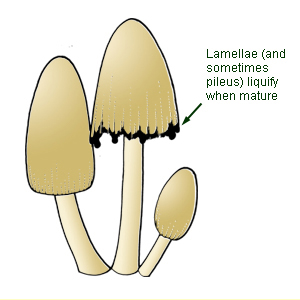
Deliquescence is an unusual phenomenon found in a few agaric genera formerly lumped together in Coprinus. The lamella (and usually also pileus) tissue liquifies by autodigestion. Deliquescence starts from the exposed edge of the lamellae and proceeds upwards. The liquified tissue forms spore-filled droplets. Deliquescence may proceed partially up the lamellae (leaving thin lines on the underside of the pileus), or all of the lamellae and the pileus may be autodigested, leaving a watery spore mass at the apex of the stipe. Deliquescence will stop if the fruit-bodies dry out too much. Rotting fungi may appear to be deliquescing, but the liquification will not be occurring in a regular fashion from the lamella edge upwards.
Choose this state if: the lamellae (and the pileus flesh) are deliquescent.
Most species of Coprinus, Coprinellus and Coprinopsis are clearly deliquescent.
In Bolbitius and Parasola, the fruit-body collapses without true autodigestion, and these genera are not considered to be truly deliquescent.
